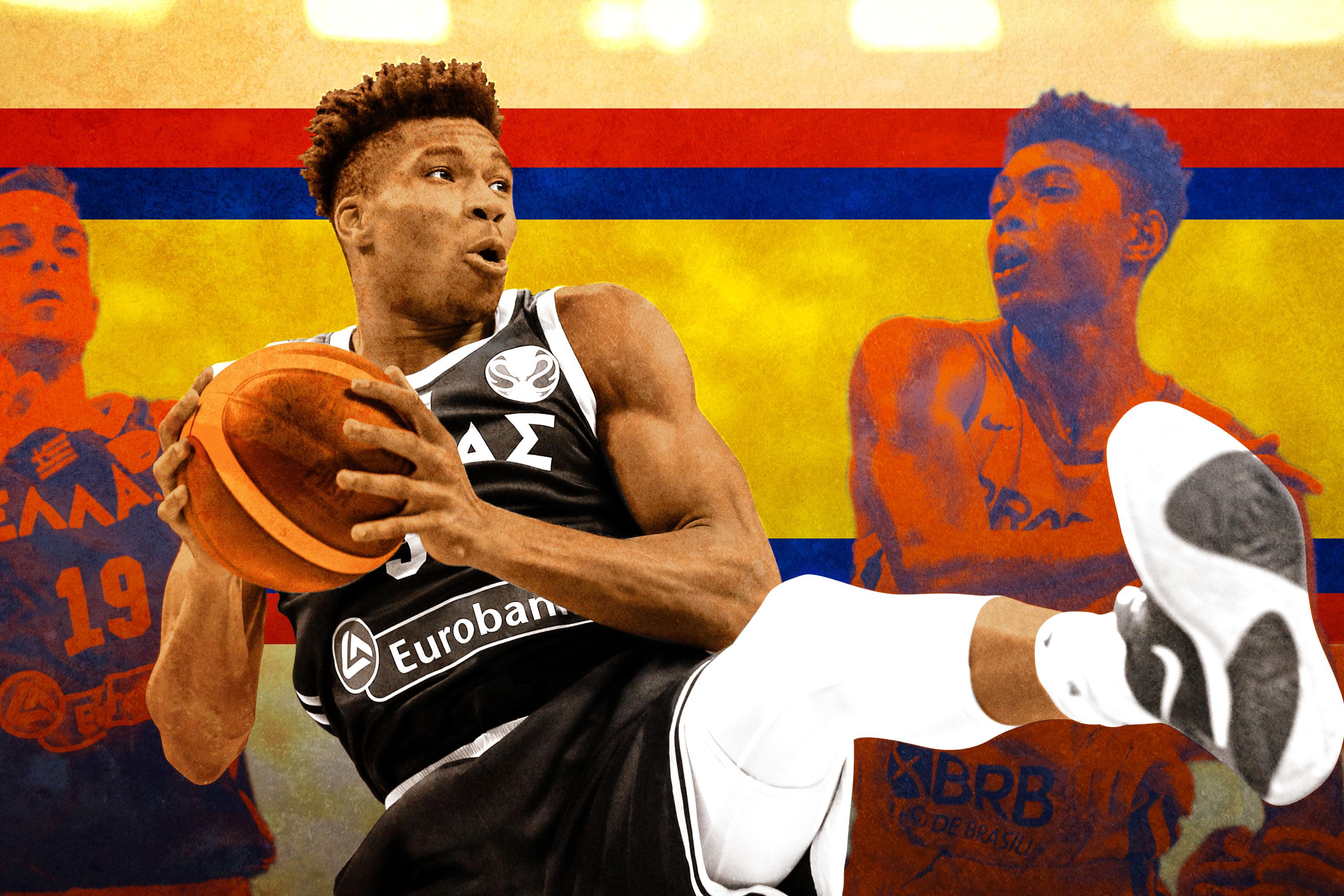
For the first time in more than a decade, Team USA doesn’t have the best player at a major international tournament. Giannis Antetokounmpo, not anyone on a depleted American squad, is the biggest star at the 2019 FIBA World Cup in China. He just won his first NBA MVP while leading the Bucks to the league’s best record and an appearance in the Eastern Conference finals. He could be the best player at the next few World Cups and Olympics, regardless of who Team USA sends. But first, Greece needs to figure out how to use its superstar.
Antetokounmpo was unstoppable in the NBA last season because he was surrounded by 3-point shooters at every position, which forced defenses to guard him one-on-one in the paint. There are only a handful of players in the world who can match up with someone who combines the size and length of a center (6-foot-11 and 242 pounds with a 7-foot-3 wingspan) with the speed and quickness of a guard.
Life has been harder for Giannis in two World Cup games—an 85-60 victory over Montenegro and a 79-78 loss to Brazil. He’s averaging 11.5 points per game on 43.8 percent shooting, compared with 27.7 points on 57.8 percent shooting with the Bucks. Defenses are packing the paint and sending multiple defenders at him every time he attacks the rim. Greece has not been able to make them pay, shooting 15-for-43 (34.1 percent) from 3 in its first two games. Giannis grew increasingly frustrated over the course of their loss to Brazil before fouling out in the final seconds.
The Greeks should be able to adjust. They have the size to match up with any team in the field: Their shortest starter (former Memphis Grizzlies point guard Nick Calathes) is 6-foot-6. They have plenty of depth, too: They bring a first-team All-EuroLeague point guard (Kostas Sloukas) and two players with NBA experience (Thanasis Antetokounmpo and Georgios Papagiannis) off their bench.
What became clear against Brazil on Tuesday is that Greece needs to play smaller with Giannis at the 5. Ioannis Bourosis, its starting center, has the ability to pop out to the 3-point line, but the 35-year-old’s lack of footspeed was exposed on defense, while Papagiannis, his backup, doesn’t have the shooting ability to play off Giannis. Greece spent far too much time putting Bourosis and Papagiannis in the pick-and-roll and forcing Giannis to stand in the corner. Its comeback in the second half against Brazil came without either of its centers on the court.
Both Antetokounmpo’s NBA team and national team should use him more in the pick-and-roll. Giannis was in the 97th percentile of NBA players last season when used as the ball handler and the 95th percentile as a roll man, but those plays accounted for only 12.6 percent of his total offensive possessions. Part of the issue for the Bucks is that neither of their point guards is a natural pick-and-roll partner for Giannis. Eric Bledsoe is an inconsistent shooter and decision-maker while George Hill isn’t dynamic enough with the ball in his hands. They could use someone like Calathes, a big guard who can pass over a double-team, shoot 3s, and make plays off the dribble.
Using Giannis as the ball handler in those plays would also allow him to dictate matchups and attack the weakest link on the opposing defense. Even if defenders go under the screen, he’s so long and quick that he can eat up space and finish over them in the lane. Plus, he’s tall enough to see over the defense and find any open shooters on the perimeter if they send help.
The problem with isolating and posting up Giannis is that he’s not a good enough shooter to knock down contested jumpers over defenders who can push him away from the basket. That was the biggest problem for the Bucks in their playoff series loss to the Raptors. They had a 2-0 lead before Toronto switched Kawhi Leonard on to Giannis. At 6-foot-7 and 230 pounds with a 7-foot-3 wingspan, Kawhi had the strength to prevent Giannis from establishing deep post position, the quickness to stay in front of him, and the length to contest his shot. Giannis shot 12-for-34 (35.3 percent) on possessions where Kawhi was his primary defender in the playoffs and 117-for-228 (51.3 percent) against everyone else.
The ability to shoot over the top of defenders like Kawhi is the final step for Giannis. It is the same challenge that LeBron James faced earlier in his career, when he was shut down in the NBA Finals by Bruce Bowen and Shawn Marion. There was nothing defenses could do once he began confidently dribbling into jumpers.
The good news for Giannis is that his jumper isn’t broken. He’s not Ben Simmons: He’s at least willing to take the shot when it’s given to him. Giannis has been a good free throw shooter (74.2 percent on 6.2 attempts per game) throughout his NBA career, while his number of 3-point attempts has steadily increased over the past few seasons:
Giannis’s 3-point Growth
Whether Antetokounmpo’s jumper will look better at the World Cup is one of the biggest story lines for the upcoming NBA season. He’s a tireless worker who has improved dramatically in his six seasons in the league, but Kawhi made him painfully aware of his limitations a few months ago. Giannis is 0-for-3 from 3 in his first two games with Greece, with one attempt coming in the first 10 seconds of their opener, almost as if he were trying to send a message about what he had been doing over the summer.
Until Giannis develops that aspect of his game, defenses will play off him on the perimeter and force him to be a passer when he gets into the lane. Greece will need to either make enough 3s with its bigger lineups or spread the floor with smaller units around Giannis like it did at the end of its loss to Brazil. Greece should be able to experiment in an elimination game on Thursday, against a New Zealand team that doesn’t have any NBA players.
The Greeks probably need to play both of their point guards (Sloukas and Calathes) alongside Giannis. The question is which of their forwards are best in a small-ball lineup. Greece starts Kostas Papanikolaou, who played two seasons in the NBA, and Ioannis Papapetrou, who excelled in one season at Texas before going back to Europe. But its best offensive option is Georgios Printezis, who is averaging 18.0 points per game on 61.1 percent shooting at the World Cup, and its best defensive option is Thanasis Antetokounmpo, who has the length (6-foot-7 and 205 pounds with a 7-foot wingspan) and athleticism to be a multipositional defender in a game against Team USA.
Playing in as much space as possible should make Giannis look more like the MVP player he was in the NBA last season. He has had some tantalizing moments at the World Cup—in one sequence against Montenegro, he ripped the ball away from his man and then dribbled through multiple defenders in transition for a monster dunk. A few minutes later, he rotated over on defense and easily swallowed up Nikola Vucevic as the All-Star center went up for a dunk.
There is no reason that Giannis couldn’t make those types of plays if Greece faces Team USA, which narrowly escaped with a 93-92 overtime win over Turkey on Tuesday. The Americans have been at their best in the tournament with smaller lineups that feature 6-foot-8 wings like Harrison Barnes and Khris Middleton up front. Those players have no chance to stop Giannis if he’s coming downhill at them. Antetokounmpo should also be able to dominate a small-ball game on defense with his ability to protect the rim, switch screens, and cut off penetration. He’s putting up big numbers in every statistical category besides scoring at the World Cup, averaging six rebounds, 2.5 steals, and one block in only 22 minutes per game.
Everything is set up for Giannis to take over the international stage. Supersized wings with elite athleticism have become the most valuable players in basketball, and none of the best ones—Kawhi Leonard, LeBron James, and Kevin Durant—are at the World Cup. It’s hard to imagine any of them playing in an international tournament again—LeBron is 34, Durant is 30 and just tore his Achilles, and Kawhi, while only 28, may need to have his playing time managed for the rest of his career.
Giannis, meanwhile, has a lot of incentive to keep playing. These international tournaments will be his only chance to play with all three of his brothers—Thanasis (who just signed a two-year contract with the Bucks), Kostas (a 21-year-old on a two-way contract with the Lakers), and Alex (an 18-year-old high school senior). Greece doesn’t have enough NBA-caliber talent to block an all-Antetokounmpo lineup. Its teams could basically be one family against the world. If Giannis continues to improve as a shooter, the Greeks could make it a fair fight.
Giannis has an unusual opportunity in front of him. The best players in basketball history are typically judged on NBA championships. It doesn’t matter how many gold medals Michael Jordan and LeBron James won in international play. But it will be different for Giannis. Team USA is expected to win every game; winning gold with a far less-talented Greece team would be an incredible accomplishment—especially at the Olympics, when the U.S. usually sends its best.
It is far more impressive to beat a Dream Team than to be on one. Doing that a couple of times would go a long way toward building a case for Giannis as the greatest player of all time.

